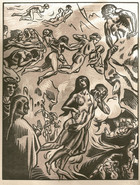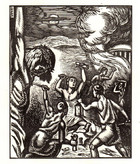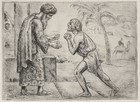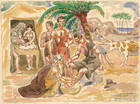Paul-Emile Colin
(1867-1949)
Some artists are better known for the company they keep. This is certainly true of Frenchman Paul-Emile Colin, whose name is usually linked with Paul Gauguin. A medical doctor who dabbled in art, Colin made the acquaintance of the Post-Impressionist painter at a commune, which had formed around Gauguin in the Breton fishing village of Le Pouldu in the summer of 1890.
Colin immediately fell under the spell of the charismatic artist, who seemed to “exude energy from every pore,” reminding him of “a fairground barker, a troubadour, or a pirate.” Colin stayed on to learn from the master, who was, then, painting symbolist works in pure color. Looking back on this extraordinary time in his life, Colin believed Gauguin had been something of “a Christ for whom we were his disciples.”
Artistic adulation has its limits. The doctor-artist from the Lorraine region of Eastern France was not going to run off to the South Seas in search of inspiration, as his mentor did in 1891. He was content to paint the less exotic landscapes of Lorraine, Ile de France, and Brittany, travelling later in life through the Mediterranean world.
When Colin finally decided to give up medicine to pursue a fulltime career in art in 1901, he turned to book illustration, excelling in the highly disciplined craft of knife-cut wood engravings. The experience of that summer in Brittany with Gauguin did linger on in Colin's stylized, line-defined compositions, his use of color, and his adept touch in summoning up the mystic realms of Dante’s Divine Comedy or the gothic horror of Edgar Allen Poe with a minimum of means.
The Sacred Art Pilgrim Collection has five works by Colin on religious themes. A print of the Inferno from a series on Dante's Divine Comedy and an illustration of the Crucified Christ from the collected works of French Author Anatole France show the artist's mastery of wood engraving. You can see this detailed linework carried over into the etching, The Prodigal Son. A second etching, Sicilian Navity, presents the birth of Christ with a Mediterranean accent. There is also a small watercolor on lined paper in the collection, depicting Abraham's meeting with the three angelic visitors, recorded in Genesis 18:1-8.





